Beginners Guide to Path of Exile: Welcome to Wraeclast - Fresh Exiles, Start Here
Introduction
Welcome, Exile!
It’s great to see you taking your first steps in Path of Exile (PoE). Path of Exile is not an easy game to pick up, being famous for its great depth and potential complexity, but we are here to help to make your journey easier and more fun from the start.
In addition to guides explaining the different mechanics of Path of Exile, we have an extensive and diverse list of character builds ready for you to explore the game with.
Builds tagged with League Starter are build guides that will cover your first minutes in the game and accompany you all the way through your journey into the post-campaign.
Following a build guide is your best option for a successful first play-through, so you can focus more on the gameplay and organically learn the core game mechanics – and above all, enjoy it.
If you would like advice on how to quickly and efficiently level through the zones in Path of Exile, please refer to our Quick Reference Leveling Guide.
Before looking at any of our guides we strongly recommend you carefully read this page and look at the more in-depth indexed above pages when they are relevant to your questions. Path of Exile is a daunting game to take on, even if you are already experienced in other ARPG titles, such as games from the Diablo, Torchlight or Titan Quest franchise. There are numerous complex and interlocking systems in the game, all of which can make your experience smoother when you become aware of how to use them.
This guide will walk you through the key systems and tricks you need to be aware of when levelling for the first time, as well as answer a host of frequently asked questions that are on the lips of every new player. Many of the systems in Path of Exile are interlocking, and it can be difficult to understand one system’s full potential without explaining another. If you encounter unfamiliar words and concepts, rest assured we will cover everything you need to know within these pages.
Before you start
Due to the complexity of systems in Path of Exile, we use external tools to make our journey easier. One of these tools is Path of Building. Path of Building is an open source and community maintained powerful build planner for Path of Exile, which allows you to test what passive tree nodes, gear and gems are most efficient and it’s the tool that our guide writers use for their build guides. Later we address the Passive Skill Tree in detail but for now we suggest you get this tool, especially if you are a PC player. We have a simple guide for you on how to install Path of Building here.
Leveling Builds vs. Build Guides
There is often a question on the minds of numerous players, new and experienced alike, of how to reconcile your end-game build with the levelling experience. All our build guides that have the League Starter tag will have a levelling section and will guide you towards end game. This section of the guides will help you in the early stages.
Starting the game for the first time
When you start Path of Exile for the first time and hit the “Create” button you will have to pick a game mode. There are 3 options to pick from and we will explain them below. Most people will play the Temporary Challenge League, and this is also whom our guides are mostly written for.
Standard League
Standard League is the permanent League. This game mode will always be available, no matter if there is a new season or not. Standard is also the mode where your characters end up after a season and where dead characters from the Season League Hardcore mode end up. Standard League does not have the content of the newest league to come out, and opportunities to accumulate wealth are limited in its well-established economy.
- Softcore or the default game mode (just select the league of your preferences and hit “OK”)
- Hardcore (When you die you are moved to the Standard League game mode)
- Solo Self-Found, commonly referred to as “SSF” (You will not be able to trade or party with other players)
- Ruthless (A very punishing mode with lesser loot and items to be found)
Challenge League
Challenge Leagues are temporary Leagues or Seasons that last around 3 to 4 months. Characters created in these leagues and their stashes will always have a fresh start and can experience the new league mechanic content and the latest balance changes. These characters will automatically migrate to the Standard League when the league ends.
- Softcore or default League mode (just select league and hit “OK”)
- SSF or Solo Self-Found (You will not be able to trade with other players)
- Ruthless (A very punishing mode with lesser loot and items to be found)
Challenge League Hardcore
Same as the default temporary Challenge League as above, with the exception that if you die, you will be placed in the Standard League and taken off the Hardcore Challenge League Ladder, which ranks player characters by experience gained.
- Hardcore or default League mode (just select league and hit “OK”)
- SSF or Solo Self-Found (You will not be able to trade with other players)
- Ruthless (A very punishing mode with lesser loot and items to be found)
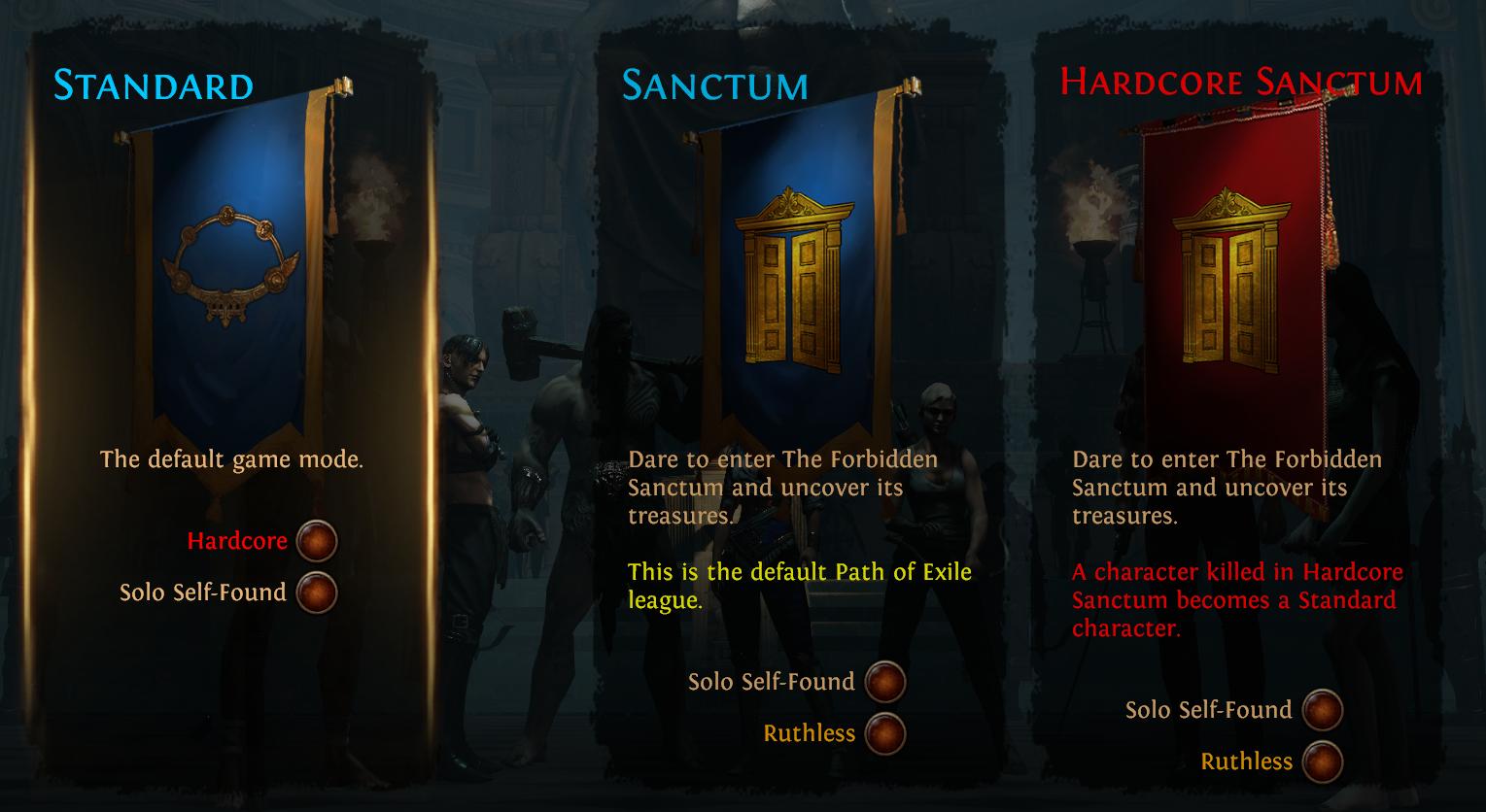
Character Classes and Core Attributes
The first deviation from the standard video game formula you’ll encounter is the class design in Path of Exile. Choosing a class affects where you start on the Passive Skill tree, rather than what abilities your character will be able to access. Certain classes are more suited to the use of certain abilities, as they reach passives on the Passive Tree that synergize with their build for less skill point investment, but no items, skills or playstyles are inherently off-limits for any of the classes, which lend themselves perfectly to any RPG fantasies you may have.
There are three core attributes in Path of Exile. They are each associated with a certain colour, which is important as it relates to many other systems within the game.
The core attributes are:
| Attribute | Color |
| Strength | Red |
| Dexterity | Green |
| Intelligence | Blue |
If we divide the passive tree roughly into three slices of a pie, each slice has many nodes related to one of the core attributes and it’s associated archetypes. While this is not an absolute rule, it is a helpful way of gaining some insight into how the Passive Tree works.

All combat skills and items have attribute requirements; for example, using the 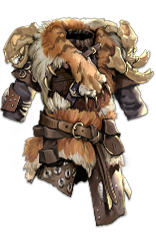 Farrul's Fur chest has a minimum requirement of 95 Strength and 116 Dexterity. Attributes also have their own benefits for every 10 points you obtain. They are as follows:
Farrul's Fur chest has a minimum requirement of 95 Strength and 116 Dexterity. Attributes also have their own benefits for every 10 points you obtain. They are as follows:
| Attribute | Bonus Per 10 Points |
| Strength | 5 Maximum Life, 2% Melee Physical Damage |
| Dexterity | 20 Accuracy Rating, 2% Increased Evasion Rating |
| Intelligence | 5 Maximum Mana, 2% Increased Maximum Energy Shield |
These attributes are associated with the classes of Path of Exile, as well as the Passive Tree itself. There are seven classes in Path of Exile, and each of them begins at a different point on the Passive Skill Tree you saw above. The starting areas of the core classes look like “wheels” on the tree. For example, here is a low level Marauder investing points from his starting wheel.
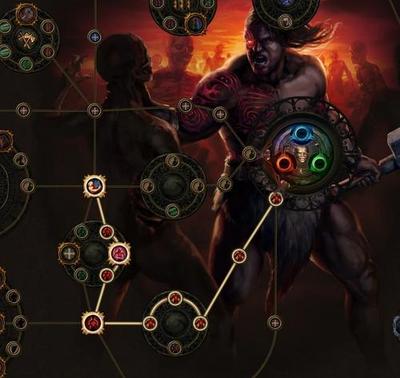
Each time you level up, you are granted a small amount of maximum life and mana, and a skill point to invest into your tree; however, you must always remain connected to your class’s starting wheel. The seven core classes are:
| Class | Attribute | Starting Stats |
| Marauder | Strength | 32 Strength, 14 Dexterity, 14 Intelligence |
| Templar | Strength/Intelligence | 23 Strength. 14 Dex, 23 Intelligence |
| Witch | Intelligence | 14 Strength, 14 Dexterity, 32 Intelligence |
| Shadow | Dexterity/Intelligence | 14 Strength, 23 Dexterity, 23 Intelligence |
| Ranger | Dexterity | 14 Strength, 32 Dexterity, 14 Intelligence |
| Duelist | Strength/Dexterity | 23 Strength, 23 Dexterity, 14 Intelligence |
| Scion | Strength/Dexterity/Intelligence | 20 Strength, 20 Dexterity, 20 Intelligence |
The Scion is a special class that starts at the centre of the tree. She is not available to new players until you have rescued her during the main storyline of the game. The reason for this is the extreme degree of customization possible, coupled with an extremely weak early game, making her very unfriendly to new players.
One thing to emphasize is there is that there is not a “best” class in Path of Exile. Unlike typical role-playing games or MMORPGs, where classes are tied to specific playstyles and content, choosing a class is one of the least important decisions in this regard in Path of Exile, as there are practically infinite builds to choose from for each class.
The main differences between classes is their Ascendancy options, which we will cover in full detail in a later section. Ascendancies are “sub-classes”, or specializations, which further diversify playstyles. Each class has 3 Ascendancy options, except the Scion, who only has 1.
Gems – The Abilities of Path of Exile
Path of Exile has a unique take on skills and abilities. All players start the game with no abilities, save for a default auto attack. Almost immediately, however, you will acquire a weapon and a skill gem.
Skill Gems are the abilities of Path of Exile, and follow the developers’ design philosophy that “everything that can be an item, is an item”. When a skill gem is placed into a socket, the ability can be used by the player, assuming you meet the requirements. The colour of the skill gem denotes the main required attribute. Gems must match the socket colour in order to be slotted in. Gems gain experience as you use them to kill monsters, and levelling up gems increases their power and effectiveness, but also their attribute requirements and mana costs.
For more information regarding Skill gems and Sockets please check out this page
League Play
The majority of Path of Exile players choose to play in the Temporary Challenge Leagues, which typically last around 3 months. You can think of Leagues as seasonal or quarterly resets on the game, each of which brings a new special twist to the game and expands it. For example, during the Beyond League, slaying groups of monsters in close proximity could cause monsters from the “Beyond” to appear and attack you. This adds some new flavour to the game every few months that many players quickly come to appreciate and interact with.
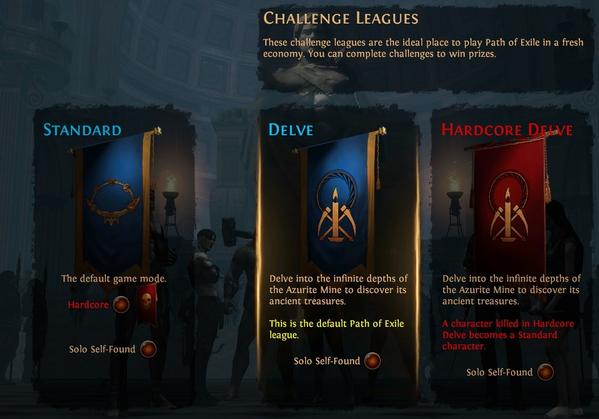
Another key benefit of League play is the economical reset it provides. All players begin on an even playing field, and the economy never has a chance to stagnate. This makes farming for items a lot more exciting, as they are worth significantly more than in the permanent “Standard” league, where there are near limitless quantities of the same items in the game already. In addition to the economic environment being more favourable to new players, they can also earn cosmetic items
and achievements for completing the league’s challenges, which often involve accomplishing certain interactions with the new mechanics or reaching farming goals within that league.
Finally, Challenge Leagues allow experienced players to “race”. Whether it is the first person to kill a new boss or the first to reach maximum level, there is always an objective that the best players want to make their mark on before anyone else.
Hardcore
Hardcore leagues are identical to their “softcore” counterparts, with the added caveat that the player only has a single life. If the player’s character dies, it is moved to the permanent Standard league.
Solo Self-Found
All leagues have a “Solo Self-Found” variant, commonly known as “SSF”. In SSF leagues, players will neither see nor be able to form a party with any other player(s). Trading is impossible, and as the name implies, everything must be acquired by the SSF player themselves.
SSF leagues are not recommended for new players, as there are specific strategies followed to help make obtaining key items a lot more manageable. There are no benefits to playing on SSF leagues versus the default “trade leagues”, as they are often referred to, and the difference is merely a choice of playstyle. Please keep in mind that if you are following any of our build guides you need to have some knowledge of the build as the items required in some builds are very hard to find compared to trade league and can be build enabling.
Ruthless
Ruthless mode (also known as Hard Mode) is a character creation flag that significantly increases the difficulty and changes the playstyle of the game by opting into extreme item scarcity and various other changes.
Named after the historical Ruthless difficulty from Closed Beta, it employs item scarcity and shifts of relative item values to simulate the Path of Exile experience in the early days (without the desync). This mode is meant to be intentionally brutally difficult, where reaching higher acts is an achievement, and traditionally weak items are felt as valuable. For example, a player may have difficulty equipping a full set of items by Act 4. Most items found will be a normal rarity, and crafting currency will be extremely rare.
This mode was designed as a pet project of Chris Wilson and other senior developers over 18 months. Features of Ruthless mode will have little to no impact on the core gameplay of the rest of the game. It is intended as a testing ground for radical changes and experiments (such as mid-league buff/nerfs). A change in Ruthless does not indicate that the change will also be made in the regular game. This mode is video game torture and not for faint-hearted.
Build Choice
Now that you understand some of the basic mechanics of the game, you will want to choose a build and create your first exile. We recommend browsing our guides for a build that appeals to you and is tagged as budget-friendly or a league starter. League Starters are a category of builds meant to function well without much currency investment or items. Many experienced players use these builds for their first character in a league, to build up wealth before embarking on a more ambitious and expensive build later on.
New players often make the mistake of choosing a build that boasts “insane damage”, or “all content viable” — this is a trap. Typically such builds are difficult to level, require a vast amount of wealth to properly outfit, or involve difficult gameplay mechanics. Many a new exile has chosen such a build, only to get smashed while levelling and have a miserable experience with the game. A mistaken belief is that if they persevere long enough, they will eventually acquire the necessary means to complete the build. This is a fallacy, however, as new players also lack the knowledge to quickly accrue wealth and identify valuable items.
Certain classes are also easier to level than others. The Marauder, for example, starts very near to a large number of Life nodes on the passive skill tree, making him innately tankier than other classes much earlier in the game. This means you will be much less likely to die from mistakes or lack of knowledge. The Witch, on the other hand, is generally a much more fragile class early in the game, and when not resorting to minion skills to address this, requires some finesse to safely level without dying.
Getting Started in Path of Exile
Select your preferred League and chosen class, christen your character with a name, and enter the dark and dangerous world of Wraeclast. You will be immediately confronted with your first enemy, and provided with a weapon to defeat it with. The weapon will be automatically equipped, and all you will need to do is simply hold left-click to auto-attack it to death.
Pick up the skill gem that it inevitably drops, and socket it into your weapon to acquire your first skill. By default, the skill will be assigned to the right mouse button, which you can reassign by clicking on any of the skill icons. By default, you will be able to move using a left click and attack enemies with a right click.
At this point, you should change your auto-attack (default binding: left mouse button) to “move only”. The basic auto-attack is virtually never used in Path of Exile, as all damage is done via our skills, granted by gems or items. Having your left mouse button configured as move only allows for much easier movement, as you accidentally misclick on enemies and interrupt your movement with an auto-attack.
To change this, simply left click on the auto attack binding itself at the bottom right hand of the screen, and select move only.
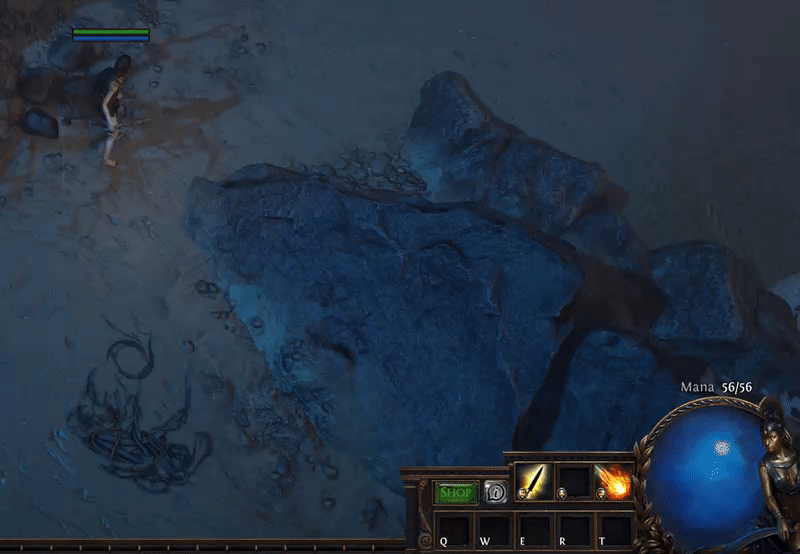
Make your way down the beach, looting your first support gem from the chest you come across. Place it into your weapon’s second socket to bolster your previously acquired skill gem. Continue to venture further down the beach, until you encounter Hillock, the first Unique enemy in the game. Unique enemies are denoted by their orange name, which signifies they are either intended to be a boss or an enemy with several unique mechanics, often having relevance to the vast game lore.
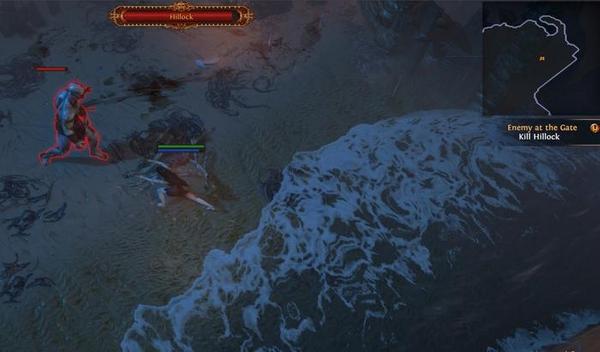
Defeat Hillock, who should not pose much of a challenge. If you need more Life or Mana during the battle, don’t hesitate to use your Flasks, which are bound on the 1-5 numerical keys by default and refill with enemy kills and visits to safe areas. If it is your first character, you will likely want to pick up the items that Hillock drops and equip them if possible. After Hillock’s defeat, the door to the game’s first encampment opens, inviting you into Lioneye’s Watch.
Encampments
Each Act in Path of Exile has its own encampment, which functions as a sanctuary and travel hub to help you move quickly around the game. Quest givers are always located in the zones, and often double as vendors that you can sell your drops or buy basic items from.
There is also a Waypoint in every encampment, which is a means of fast travel throughout the world of Wraeclast. While you adventure throughout the game, you will encounter inactive waypoints which can be activated by simply left clicking on them. Once active, they are permanently unlocked for your character and can be used to quickly travel between other unlocked waypoints.
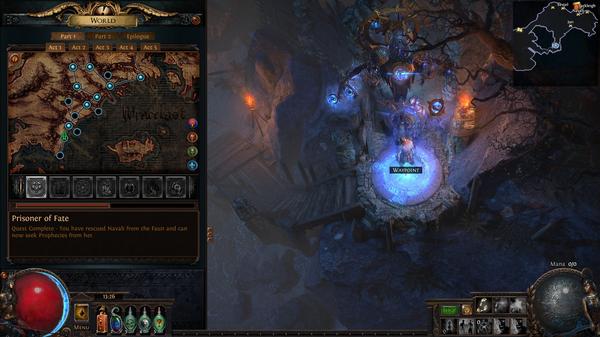
Characters with pending quests are designated by exclamation marks above them, and speaking with them will automatically accept the quest. Quests do not have to be accepted in order to be completed, and will automatically be added to your log if you complete an action that is related to the quest. Picking them up manually is helpful for new players, however, as it places them in a quest tracker on the right side of the screen, which makes navigating areas much easier and allows you to follow the story thread without interruption.
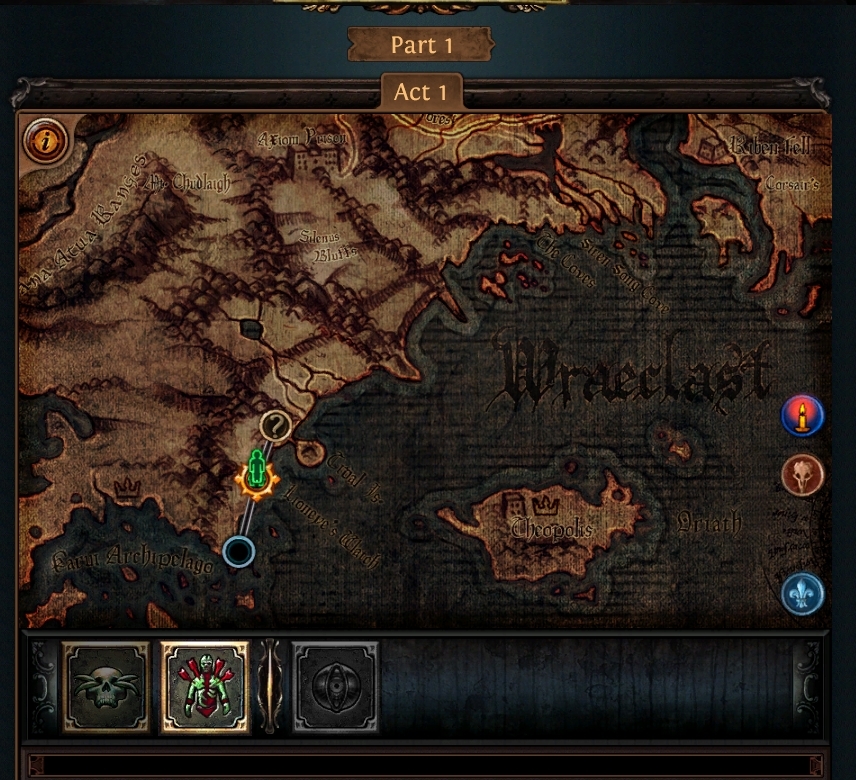
By default Pressing ”U” will open the Quest Log and World Map, which shows any connected areas and waypoints. You can select a different active quest by left clicking on them, however, this is only helpful for navigational purposes.
From this point onward you can either follow your quest log or follow our comprehensive levelling guide that you can find here
Ascendancy and the Labyrinth
Ascending is an important part of Path of Exile that allows you to turn your base class into a more specialized sub-class for your build. A Witch that wants to increase the potency of their Fire, Cold or Lightning Damage, for example, would likely choose the Elementalist Ascendancy, while a Marauder seeking to bolster their Regeneration and defences would become a Juggernaut.
To Ascend, the player must complete the Lord’s Labyrinth without dying. The Labyrinth has four different difficulties, and each rewards you with 2 Ascendancy points when completed for the first time. In order to attempt the Labyrinth, the player must complete the related Ascendancy Trials, of increased difficulty. This must only be done once per league, and Trial completion is shared between all characters.
| Labyrinth Denomination | Monster Level | Trial Locations |
|---|---|---|
| Normal Lab l | 33 | The Lower Prison, The Crypt (Level 1), The Chamber of Sins (Level 2), The Crematorium, The Catacombs, The Imperial Gardens |
| Cruel Lab | 55 | The Prison (Act VI), The Crypt (Act VII), The Chamber of Sins (Level 2, Act VII) |
| Merciless Lab | 68 | The Bath House, The Tunnel, The Ossuary |
| Eternal Lab | 75 | Pay one Offering of the Goddess |
To triumph in The Labyrinth, the player must defeat the boss Izaro three times. In each encounter, the player must deal 33% of his health in order to succeed. Izaro has different incarnations, and he is always accompanied by bodyguards or buffs. Just like the Labyrinth layout itself, the combinations are changed every day.
The website poelab.com is extremely valuable for determining the current layouts, affixes, puzzle solutions, and more.
The Importance of Resistances
There are five primary forms of damage in Path of Exile: physical, Chaos, and the ones collectively known as Elemental are Cold, Lightning, and Fire. Players and monsters alike can have Resistance to these damage types, which can greatly reduce the amount of damage they take.
Elemental Resistances are the most important aspect of your character’s survival.
Resistance for each Element is capped at 75%. This means that while you may have a total of 150% Fire Resistance, only 75% will be applied to reductions from Fire damage. If your character were to be cursed to have reduced Fire resistance, however, this excess Resistance would act as a buffer so that you remain Resistance capped despite the debuff.
You can see your character’s Resistances by opening the Character Pane ( C ) and clicking on the defence tab.
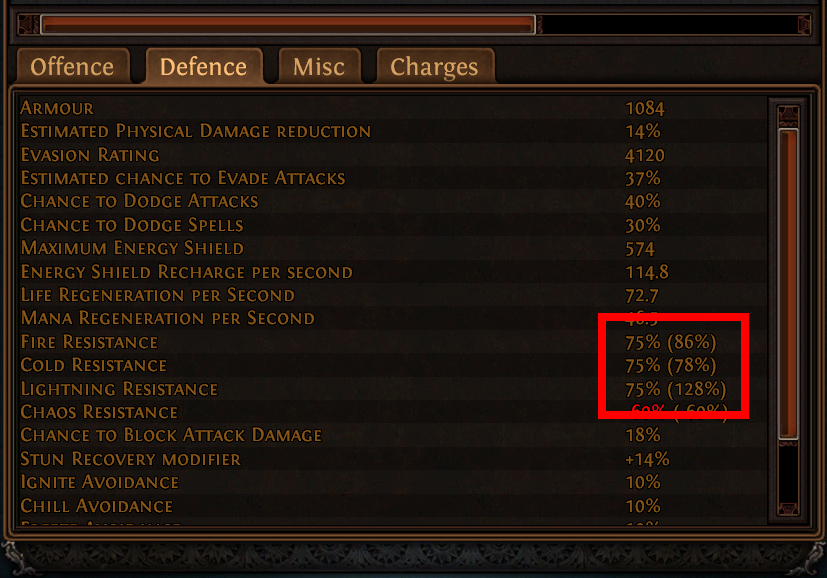
The numbers in brackets are the “Uncapped” or total resistances, while the number on their left is the capped Resistance value that is being utilised for damage reduction. Resistance caps can be raised beyond their normal value using certain means, such as skills like  Purity of Fire gem and and other elemental resistance auras and certain items such as
Purity of Fire gem and and other elemental resistance auras and certain items such as 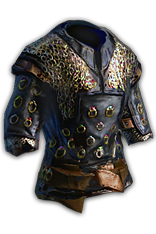 Loreweave or
Loreweave or 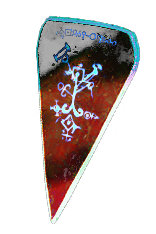 Saffell's Frame. There are also several skill nodes on the Passive Tree that can increase maximum Resistances.
Saffell's Frame. There are also several skill nodes on the Passive Tree that can increase maximum Resistances.
It is extremely important you stay at 75% Cold, Fire, and Lightning Resistance whenever possible. Resistance is generally found on items, although there are also a wide variety of Passive Skill tree nodes that offer additional Resistance.
There are penalties to Resistances that increase throughout the game. When you start the game in Act I, the default Resistance value is 0%. As you progress further into the game, however, there are additional penalties applied to Resistances, as your gear will also get better and better to counteract this.
| Resistance Penalty | Applied In Act |
|---|---|
| 0% | Act I |
| -30% | Act VI |
| -60% | Epilogue |
Essentially, this means that if you had 75% Cold Resistance in Act I-V, you would have 45% in Act VI, and only 15% upon reaching the Epilogue. The only way to counteract this is to continually upgrade your equipped items as you level up and progress further into the game.
For more information regarding Resistance please check out this page
The Importance of Flasks
Flasks are one of the most singular and important mechanics that govern your character’s ability to succeed in Path of Exile, and perhaps even the most important in many situations. Having a good flask setup will greatly ease the levelling process, particularly in Act V and beyond.
Life and Mana flasks are the standard Flasks everyone starts the game with, and many newer players never use anything else until they reach the end-game. Certain flasks, however, can be extremely valuable while leveling up due to their imbalance at lower levels.
The Quicksilver Flask is the most important flask for levelling. Early in the game, it can be extremely beneficial to even have 2 of them, allowing you to have to kill fewer monsters and to be able to run through the low level Acts much faster. One important note is that the ideal suffix for Quicksilver Flasks (of Adrenaline) can only be obtained on a flask of Item Level 5 or higher. The Quicksilver Flask obtained from the “Medicine Chest” quest (from Nessa in Act I) has an Item Level of 3, and therefore cannot have this very attractive suffix. Quicksilver Flasks are a fairly common drop, so keep your eyes peeled and you will likely find a few extras by around Act III.
The  Granite Flask provides a flat +1500 Armour to your exile for its duration, which can be further increased by the “of the Iron Skin” suffix. This flask can be used as early as Level 27, which makes it an extremely potent choice for leveling. Walking into a pack of monsters in Act IV or Act V with +1500 Armour or more results in your exile taking practically no Physical damage, which can be a godsend on fragile characters that might otherwise struggle at this point in the game.
Granite Flask provides a flat +1500 Armour to your exile for its duration, which can be further increased by the “of the Iron Skin” suffix. This flask can be used as early as Level 27, which makes it an extremely potent choice for leveling. Walking into a pack of monsters in Act IV or Act V with +1500 Armour or more results in your exile taking practically no Physical damage, which can be a godsend on fragile characters that might otherwise struggle at this point in the game.
If you are playing a character that concentrates on the right-side of the Passive Tree and whose build is focused on evasion, you might prefer a  Jade Flask for its 1500 evasion, usable at the same level as Granite Flask, 27.
Jade Flask for its 1500 evasion, usable at the same level as Granite Flask, 27.
The Diamond Flask increases Critical Strike chance by a significant ammount, and is a great option for characters that rely heavily on critical strikes. Since obtaining a consistent Critical Strike chance is difficult while leveling, this flask can smooth the process considerably.
The Silver Flask fits into many builds while levelling, providing the Onslaught buff for its duration. Onslaught increases attack speed, cast speed, and movement speed by 20%, which is great for both damage and getting around faster.
There are a variety of other flasks in Path of Exile, many of which are excellent in the end-game, or fit into certain builds specifically. Once you have reached Act V or so, and are looking to proceed into “Part 2” of the game, you should be running more than just simple Life and Mana flasks. In fact, multiple Mana flasks is generally quite useless for levelling, unless you are running the keystone Mind Over Matter. If you are having Mana issues, simply run the  Clarity aura while leveling. Do not run any more than 2 Life Flasks, either.
Clarity aura while leveling. Do not run any more than 2 Life Flasks, either.
Understanding Experience Gain
Unlike many RPGs, Quests do not grant experience in Path of Exile. The only way to increase the experience of your character and level up is to kill enemies that are within your level range. Killing enemies that are close to the level of your character grants the maximum amount of experience, however, killing enemies that are too high or too lowly levelled grants nothing.
For a new player, you will likely want to stick to killing monsters that are roughly the same level as your character to avoid any difficulties. Press Tab to see the instance information displayed at the top right, including the monster level.
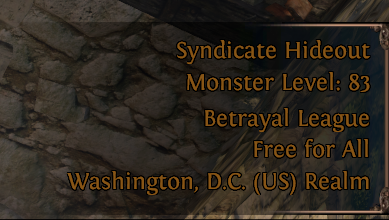
A common mistake that new players make is trying to fully clear every zone of monsters. While this does become necessary late in the game, it is extremely inefficient to do so in the early acts, as you will end up extremely over-levelled. Additionally, the drops for these low-level monsters are extremely poor, so there is practically no incentive to kill any more than necessary.
For peak efficiency, it is ideal to be a few levels below the zone you are currently in. Advanced players will often intentionally ensure their character is 2-3 levels below the zones they are progressing in, as that is generally the range that maximum experience is rewarded.
Experience values to level up taper very heavily as you gain levels. While you will only need to kill a few monsters to go from level 1 to level 2, you will have to clear entire zones to level up once you are in the 50s. The maximum level is 100, although this is a hefty milestone that many players never reach. The experience jumps are so extreme in the 90s that it actually takes more experience to go from 99 to 100 than all the levels from 1 to 97.
Losing Experience
Dying in Path of Exile imposes an experience penalty. Players progressing through Acts 1-5 will receive no penalty on death, however, in order to give newer players time to familiarize themselves with the basic mechanics of the game.
Once Kitava is encountered for the first time, at the end of Act V, a hidden penalty will be imposed. Each death will remove 5% of your experience bar. Once Kitava is encountered for the second time, at the end of Act X, this penalty is increased to 10% per death.
Players cannot lose levels from dying; the experience bar will simply reach 0% but go no further.
Currency in Path of Exile
Path of Exile has one of the most unique and engaging currency systems in any game to date. There are a variety of currency items, called “Orbs”, within the game world. The orbs all have a practical usage; for instance, the  Orb of Fusing can be used to link together sockets in an item. The value of the orb is determined by a combination of practical value and rarity.
Orb of Fusing can be used to link together sockets in an item. The value of the orb is determined by a combination of practical value and rarity.
One orb, in particular, is used for most transactions, or as a relative “dollar value” within the game that all other orbs are measured against. This unit of currency is called the  Chaos Orb and is the most common form of payment accepted when trading with other players. Most other orbs are measured in their relative value to the Chaos Orb. This is best tracked using the website poe.ninja to determine their values.
Chaos Orb and is the most common form of payment accepted when trading with other players. Most other orbs are measured in their relative value to the Chaos Orb. This is best tracked using the website poe.ninja to determine their values.
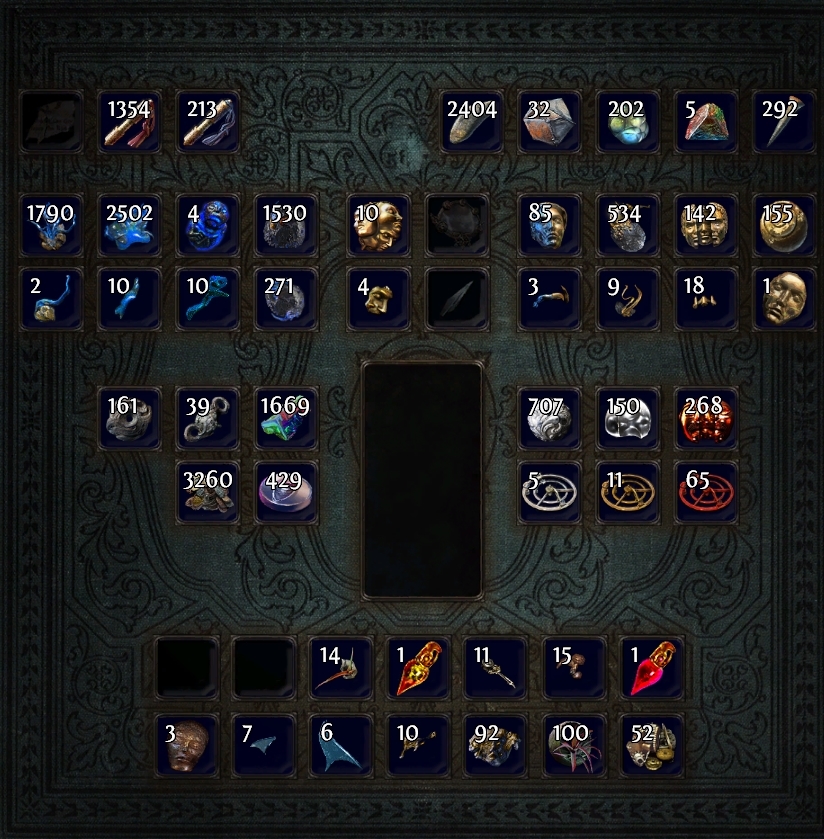
The value of currency is not fixed, and is determined by market demand. For example, the  Orb of Fusing usually starts the league quite cheap, being worth about 0.25 Chaos each. After a week or two, however, when players are trying to link their newly acquired end-game gear, the value can often double or triple as the demand for them greatly increases.
Orb of Fusing usually starts the league quite cheap, being worth about 0.25 Chaos each. After a week or two, however, when players are trying to link their newly acquired end-game gear, the value can often double or triple as the demand for them greatly increases.
Installing a Loot Filter
There are thousands upon thousands of items and currencies in Path of Exile, and it would be impossible to teach a fresh exile every single one to keep an eye out for. Fortunately, a Loot Filter is a great way to highlight the best and rarest drops while filtering out the items that are not worth picking up. It only takes about two minutes to do, and is necessary at higher levels, where so much loot is dropping that it can obstruct your screen entirely. Take a look at this comparison below, showing the same loot with no filter (top) versus a basic loot filter (bottom).
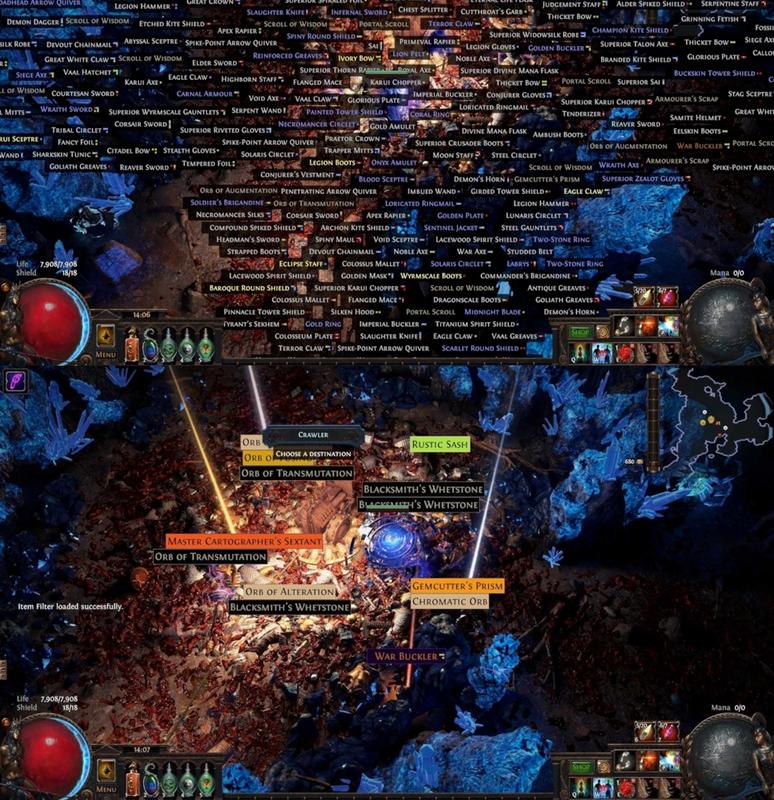
Having a Loot Filter will greatly reduce confusion for new and seasoned players alike, highlighting the rarest and most valuable items with colours, sounds, and more visible text. Most of the useless items are filtered so that they are longer seen, and this level of strictness can be changed later on if need be. Higher level players, or those with greater wealth, often choose to run stricter filters, only stopping to loot items that are “worth their time”.
For more information regarding loot and loot filter please check out this page
Afterword
If you are a new player and confused by a game mechanic that you have not found in the guide, please come to our discord and request assistance there. One of our moderators, or community members, will be with you as soon as possible.
- Our beginner guide to Path of Exile, which answers many of the questions new players might have and will set you on the right path.


